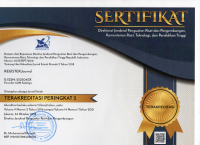Designing an English reading instructional model incorporating Islamic content for Integrated Islamic High Schools
Abstract
Keywords
Full Text:
PDFReferences
Angraini, W., & Rozimela, Y. (2020). Implementation of genre based approach in teaching reading at senior high school. Annual Proceedings in Language and Education, 5(2), 98–110. https://doi.org/10.2991/assehr.k.200819.020
Asmawati, A., & Riadi, A. (2022). Integrating Islamic values into English materials. ELSTIC: English Language, Linguistics, and Culture International Journal, 2(3), 224–230. https://doi.org/10.24252/elstic-ij.v2i3.34684
Berlin, A. W., Apriliaswati, R., & Rezeki, Y. S. (2021). Developing e Module of Islamic reading text materials for MAN 1 Pontianak (Grade 10). FTL Journal, 7(1). https://doi.org/10.18196/ftl.v7i1.13210
Berutu, N. N., & Margana. (2023). Developing English instructional materials for young learners oriented to left and right brain accommodation. JOLLT Journal of Languages and Language Teaching, 11(4), 735–747. https://doi.org/10.33394/jollt.v11i4.8900
Chen, H. I., & Su, Y. C. (2011). A genre-based approach to teaching EFL summary writing. ELT Journal, 65(2), 184–192. https://doi.org/10.1093/elt/ccq057
Derewianka, B. M. (2003). Trends and issues in genre-based approaches. RELC Journal, 34(2), 133–154. https://doi.org/10.1177/003368820303400202
Douglass, S. L., & Shaikh, M. A. (2004). Defining Islamic education: Differentiation and applications. Institute for Social Policy and Understanding.
Halliday, M. A. K., & Hasan, R. (2014). Cohesion in English. Routledge.
Harmer, J. (2007). How to teach English. Longman.
Hartoyo, I. (2021). Developing English reading material by using Genre-Based Approach for Grade X of Beauty Program at SMK Pariwisata Imelda Medan. REGISTER: Journal of English Language Teaching of FBS-Unimed, 10(2), 29962. https://doi.org/10.24114/reg.v10i2.29962
Hu, X., Ilangko, A. L. S., & Khan, A. (2024). Genre-based instruction of English reading in a polytechnic university. Theory and Practice in Language Studies. https://doi.org/10.17507/tpls.1406.11
Hyland, K. (2004). Genre and second language writing. University of Michigan Press.
Joyce, B., Weil, M., & Calhoun, E. (2011). Models of teaching (8th ed.). Pearson Education.
Kemendikbudristek. (2024, 27 Maret). Peraturan Menteri Pendidikan, Kebudayaan, Riset, dan Teknologi Nomor 12 Tahun 2024 tentang Kurikulum pada PAUD, Jenjang Pendidikan Dasar, dan Jenjang Pendidikan Menengah.
Krashen, S. D. (1982). Principles and practice in second language acquisition. Pergamon Press.
Kuzairi. (2022). Learning English through Islamic historical content. Adabuna: Jurnal Pendidikan dan Pemikiran, 2(1). https://doi.org/10.38073/adabuna.v2i1.910
Li, M. (2016). The application of genre-based teaching approach in college English reading teaching. In Proceedings of the 2nd International Conference on Social Science, Education, Economics and Management Research (SEIEM-16). https://doi.org/10.2991/SEIEM-16.2016.65
Marzuki, A. G. (2016). Utilizing cooperative learning in Islamic college students’ classroom. Indonesian Journal of English Education, 3(2), 123-139. DOI: 10.15408/ijee.v3i2.5528
Maspul, K. A. (2024). Integration of Reading and New Literacies with Islamic Education. Jurnal Penelitian Ilmu Ushuluddin, 4(1), 1–17. https://doi.org/10.15575/jpiu.v4i1.31717
Maulida, D. S., & Gunawan, H. S. (2025). Integrating genre-based approach in designing English syllabus for Islamic Education Study Program. Journal of English Language Teaching and Learning, 6(2), 184–195. https://doi.org/10.18860/jetle.v6i2.32136
Miles, M. B., Huberman, A. M., & Saldana, J. (2014). Qualitative data analysis: A methods sourcebook (3rd ed.). Sage Publications, Inc.
Minas, A., & Charles, A. (2020). Character schools in supporting character education in students. Journal Educational Verkenning, 1(2). https://doi.org/10.48173/jev.v1i2.52
Munir, M. (2013). Pengembangan pendidikan Islam integratif di sekolah Islam terpadu. Grafindo Litera Media.
Muzammil, S., & Suhono, S. (2019). Providing explicit strategy instruction to enhance students’ reading comprehension at English for Islamic Studies class. DOI: 10.26638/JS.900.203X
Nishanthi, R. (2018). Importance of learning English in today's world. International Journal of Trend in Scientific Research and Development, 3(6), 464–466. https://doi.org/10.31142/ijtsrd19061
Niyozova, A. I. (2020). The importance of English language. International Journal on Orange Technologies (IJOT), 2(1), 22. https://doi.org/10.31149/ijot.v2i1.478
Noorhaidi, H. (2009). Islamizing formal education: Integrated Islamic school and a new trend in formal education in Indonesia. RSIS Working Paper, No. 172. NTU.
Nurazizah, N., & Sutarsih, C. (2019). Implementation of character education through school culture. Proceedings of the 2nd International Conference on Research of Educational Administration and Management (ICREAM 2018). https://doi.org/10.2991/ICREAM-18.2019.20
Rafiqie, M., Shaleh, M., & Winarso, H. P. (2023). Classroom action research as a solution for the problems at Islamic religious education study in classrooms. Edupedia: Jurnal Studi Pendidikan dan Pedagogi Islam. DOI: 10.35316/edupedia.v8i1.3322
Rahmawati, R., Kamsinah, K., Rahman, I. F., & Muthi'ah, M. (2022). Integrating Islamic values into the development of progressive action unit of the eighth-grade student at MTs Madani Pao-Pao. English Language, Linguistics, and Culture International Journal. DOI: 10.24252/elstic-ij.v2i1.28445
Ramadhani, G., Nidi, I. V., & Zahra, L. (2024). The role of communicative language teaching (CLT) in teaching English to Indonesian elementary school students within the Kurikulum Merdeka. STAIRS: English Language Education Journal. https://doi.org/10.21009/stairs.5.2.7
Riswanto, R. (2016). Supplementary Reading Materials for Madrasah Learners based on Genre Approach. Jurnal Pendidikan Islam, 2(3), 1530–1539. https://doi.org/10.15575/jpi.v2i3.779
Rochmahwati, P. (2019). Integrating Islamic values into ESP reading material. NOBEL: Journal of Literature and Language Teaching, 10(2), 149–162. https://doi.org/10.15642/NOBEL.2019.10.2.149-162
Septiyana, L., Ninsiana, W., Yuniasih, E., & Laily, F. N. (2022). Development of Islamic text-based reading materials with a genre-based approach. Pedagogy: Journal of English Language Teaching, 10(2), 169–182. https://doi.org/10.32332/joelt.v10i2.52
Usman, A. H., & Mahmud, A. (2024). Addressing low speaking proficiency in EFL students: The impact of integrated teaching strategies in an Islamic education setting. International Journal of Language Education. DOI: 10.26858/ijole.v8i3.66493
Yang, W. (2015). Applying genre-based teaching approach in graduate English reading instruction. In Proceedings of the International Conference on Social Science, Humanities and Education (ICSSHE-15). https://doi.org/10.2991/ICSSHE-15.2015.112
Yuan, S. (2018). Genre-based approach in teaching Business English. In Proceedings of the 3rd International Conference on Management Science and Human Social Development (pp. 165–168). https://doi.org/10.2991/MSHSD-17.2018.29
Yuliani, A., Maftuh, B., Sapriya, A., Sujana, A., & Hayati, R. F. (2024). The implementation challenges of character education in primary schools. Jurnal Cakrawala Pendas, 10(2). https://doi.org/10.31949/jcp.v10i2.8032
DOI: https://dx.doi.org/10.30659/e.11.1.1-18
Refbacks
- There are currently no refbacks.
Copyright (c) 2025 seful bahri, Rini Susanti Wulandari, Hendi Pratama
License URL: https://creativecommons.org/licenses/by/4.0/










